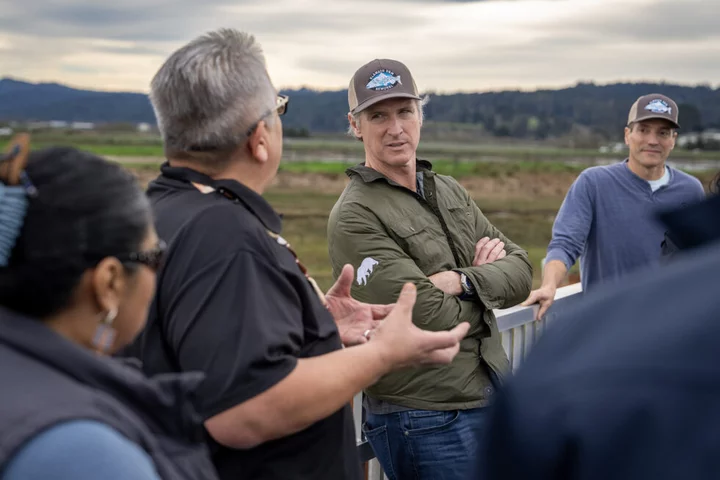Newsom meets with Ted Hernandez, chair of the Wiyot Tribe. Photo courtesy the Governor’s Office.
Press release from the Office of Gov. Gavin Newsom:
Governor Gavin Newsom today announced new actions and efforts already underway that California is taking to help restore California’s salmon populations.
After 10 years of rapidly intensifying drought and more extreme weather, salmon are not doing well. Last year, with projections showing Chinook salmon population at historic lows, the salmon season was closed and the Newsom Administration requested a Federal Fishery Disaster to support impacted communities. Additionally, due to crashing salmon populations in 2023, some tribes canceled their religious and cultural harvests for the first time ever.
Yesterday, the Governor visited salmon restoration sites in Humboldt County to see how the Salmon Strategy will support communities across the state.
THE STRATEGY: California is working to reverse these trends and save salmon. The state’s Salmon Strategy specifies the six priorities and 71 actions to build healthier, thriving salmon populations in California.
The strategy’s six priorities call for:
- Removing barriers and modernizing infrastructure for salmon migration
- Restoring habitat
- Protecting water flows in key rivers at the right times
- Modernizing hatcheries
- Transforming technology and management systems
- Strengthening partnerships
WHY IT MATTERS: Salmon are central to religions, creation stories, the health and subsistence of California Native Tribes, and a multi-million-dollar fishing industry. A multitude of factors have led to a decline in salmon populations, from ocean temperatures to drastic alteration of river habitat and flows by dams and water diversions.
PARTNERING WITH TRIBES: The Salmon Strategy relies on strong partnerships with tribal nations. Tribes and Native communities are driving policy and science critical to rebuilding California’s salmon populations. This strategy builds on existing partnerships in tribally-led restoration work, beaver reintroductions, and returning salmon to their ancestral homes.
ACTIONS & INVESTMENTS UNDERWAY: California is not waiting. The Newsom Administration and Legislature have already spent $796.4 million in state investments over the last three years to protect and restore salmon populations.
Recent actions include:
- Largest Dam Removal in History: Restoring the Klamath River, which was once a prodigious producer of salmon, by removing four obsolete hydroelectric dams. One dam was taken down last September and the rest are slated for removal by November 2024, restoring nearly 400 miles of once-blocked river to salmon, steelhead, lamprey and other native fish species.
- Bringing Fish Back to Historical Habitat: Moving endangered adult winter-run and threatened spring-run Chinook salmon to the upper reaches of Sacramento River tributaries at the height of the 2020-2022 drought, where colder water temperatures better support spawning and help salmon eggs survive. This effort returned adult winter-run to the North Fork of Battle Creek for the first time in more than 110 years
- Doing the Science: Boosting the resilience of hatchery-raised salmon with injections of thiamine (Vitamin B) to counter a deficiency that researchers believe has depressed survival of their offspring in recent years. The deficiency has been tied to shifting ocean conditions and salmon feeding primarily on anchovies compared to a more diverse diet of forage fish, krill and other species.
- Fixing the Landscape: Restoring approximately 3,000 acres of tidal wetland where the Sacramento River drains to San Francisco Bay, creating habitat beneficial to native fish and wildlife, including salmon.
- Flows for Fish: In the Scott and Shasta rivers in the Klamath Basin and Mill Creek in the Sacramento Valley, beginning efforts to establish minimum instream flows while working with local partners and tribes on locally driven solutions.
- Expanding Partnerships with Tribes: From signing a co-management agreement with the Winnemem Wintu Tribe to bring salmon back to the McCloud River for the first time since construction of Shasta Dam, to investing in tribally led restoration like the Oregon Gulch, Farmers’ Ditch, and post-McKinney fire projects with the Yurok and Karuk Tribes, to beaver reintroductions.
- Modernizing and Removing Infrastructure: Reaching agreement with local and federal partners on a framework to reopen miles of Yuba River habitat to multiple native fish species. The agreement sets the stage for the return of imperiled spring-run Chinook salmon to their native habitat in the North Yuba River for the first time in more than 100 years. And, taking the next big step with a coalition of counties, tribes, and fish conservation groups to create California’s longest free-flowing river – the Eel River – through the decommissioning of outdated infrastructure.

CLICK TO MANAGE